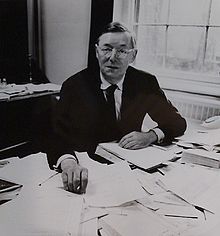John Pope-Hennessy
John Wyndham Pope-Hennessy | |
|---|---|
 | |
| Born | 13 December 1913 London, England |
| Died | 31 October 1994 (aged 80) Florence, Italy |
| Resting place | Cimitero degli Allori, Florence |
| Education | Downside School, Somerset |
| Alma mater | Balliol College, Oxford |
| Occupation(s) | Art historian and museum director |
Sir John Wyndham Pope-Hennessy CBE FBA FSA (13 December 1913 – 31 October 1994), was a British art historian and Director of the British Museum (1974 – 1976). He was a scholar of Italian Renaissance art. Many of his writings, including the tripartite Introduction to Italian Sculpture and his magnum opus, Donatello: Sculptor, are regarded as classics in the field.
Early years
Pope-Hennessy was born into an Irish Catholic family in Belgravia, London, to Major-General Richard Pope-Hennessy and Dame Una Pope-Hennessy (née Birch), who was the daughter of Arthur Birch, Lieutenant-Governor of Ceylon. He was the elder of two sons; his younger brother James Pope-Hennessy was a writer of note.
Education
Pope-Hennessy was educated at Downside School, a Roman Catholic boarding independent school for boys, in the village of Stratton-on-the-Fosse in Somerset, followed by Balliol College at the University of Oxford, where he read modern history. At Oxford, he was introduced by Logan Pearsall Smith (a family friend from the United States) to Kenneth Clark, who became a mentor to the young Pope-Hennessy.
Life and career

Upon graduation, Pope-Hennessy embarked on what he referred to as his Wanderjahre, travelling in continental Europe and becoming acquainted with its great art collections, both public and private.
Between 1955 and 1963, Pope-Hennessy's Introduction to Italian Sculpture was published in three volumes, covering Gothic, Renaissance and High Renaissance and Baroque sculpture. It has been said of these that "few books have dominated their field of study so thoroughly, or for so long".[1]
Pope-Hennessy served as the director of the Victoria and Albert Museum between 1967 and 1973, and then as the director of the British Museum from 1974 until 1976. His nickname to staff was "the Pope".
Traumatised by the murder of his brother James in January 1974, Pope-Hennessy left the British Museum after only two years as director. Initially he withdrew to Tuscany, but was enticed by an offer from the Metropolitan Museum of Art to head its department of European painting, and moved to New York. He combined this curatorial post with a professorship at New York University's Institute of Fine Arts, and enjoyed mixing with the city's high society. His apartment was known to be lavishly furnished and he is said to have owned a large porphyry table.
Death

Pope-Hennessy retired at 75 and moved permanently to Florence, at Palazzo Canigiani, where he died five years later. He is buried in the Cimitero Evangelico degli Allori in the southern suburb of Florence, Galluzzo, Italy.
Selected works
- A Lecture on Nicholas Hilliard, London, 1949
- Introduction to Italian Sculpture. 3 vol. in 5. London, 1955–63
- Donatello: Sculptor. London, 1993
- Essays on Italian Sculpture. London, 1968
- Catalogue of Italian Sculpture in the Victoria and Albert Museum. 3 vol. London: HMSO, 1964
- Italian Paintings in the Robert Lehman Collection, 1987, The Metropolitan Museum of Art, New York, ISBN 0870994794; full text available online from The Metropolitan Museum of Art Libraries
See also
References
Notes
- ^ Hall, James (Summer 2000), "A towering colossus", Art Quarterly, p. 58
Further reading
- Higgins, John. "Hennessy, Sir John Wyndham Pope (1913–1994)". Oxford Dictionary of National Biography (online ed.). Oxford University Press. doi:10.1093/ref:odnb/55258. (Subscription or UK public library membership required.)
External links
- Remarks made at the reception honoring Sir John Pope-Hennessy, a fully digitized 16 page work from The Metropolitan Museum of Art Libraries
- Finding aid for the John Pope-Hennessy papers at the Getty Research Institute.
- Use dmy dates from March 2012
- 1913 births
- 1994 deaths
- English art historians
- British curators
- Directors of the British Museum
- Directors of the Victoria and Albert Museum
- People associated with the Metropolitan Museum of Art
- Alumni of Balliol College, Oxford
- People educated at Downside School
- British people of Irish descent
- Commanders of the Order of the British Empire
- Fellows of the British Academy
- Fellows of the Society of Antiquaries of London
- Academics of the University of Cambridge
- Slade Professors of Fine Art (University of Oxford)
